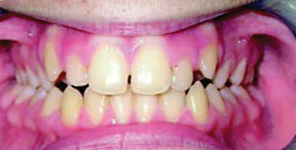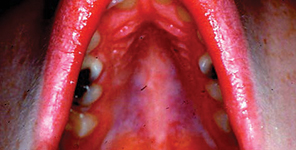Restricted Maxilla, High Palate

A normal palate is shallow and with a large arch. When the tongue rests low habitually, there is a prolonged thumb sucking habit and proper nasal breathing is absent the force of the cheeks push the maxilla inward, changing the shape of the palate and the nasal cavities that share the palate, causing further nasal restrictions.
OMT
HELPS

Because the palate divides the oral from the nasal cavity, a high narrow palate could be the symptom or the cause of difficult nasal breathing, with other disorders linked to it: craniofacial disorders, TMJD, malocclusion, muscle hypotonia, chewing and swallowing disorders, sleep disorders and more.
IF NOT
TREATED

Because the palate divides the oral cavity from the nasal cavities, a high narrow palate could be the symptom or the cause of reduced or absent nasal breathing, with all the disorders that are linked to it: craniofacial disorders, TMJD, malocclusion, muscle hypotonia, chewing and swallowing disorders, sleep disorders and more. Not retraining the tongue and orofacial muscles after palatal expansion leads to need a permanent retainer or orthodontic relapse and further malocclusion.

22. High Palate
–Katyal V, Pamula Y, Daynes CN, Martin J, Dreyer CW, Kennedy D, Sampson WJ. Craniofacial and upper airway morphology in pediatric sleep-disordered breathing and changes in quality of life with rapid maxillary expansion. Am J Orthod Dentofacial Orthop. 2013 Dec;144(6):860-71. doi: 10.1016/j.ajodo.2013.08.015.
–Conti PB, Sakano E, Ribeiro MA, Schivinski CI, Ribeiro JD. Assessment of the body posture of mouth-breathing children and adolescents. J Pediatr (Rio J). 2011 Jul-Aug;87(4):357-63.doi:10.2223/JPED.2102. Epub 2011 Jul 18. –Freng A. Restricted nasal respiration, in uence on facial growth. Int J Pediatr Otorhinolaryngol.
1979 Dec;1(3):249-54.